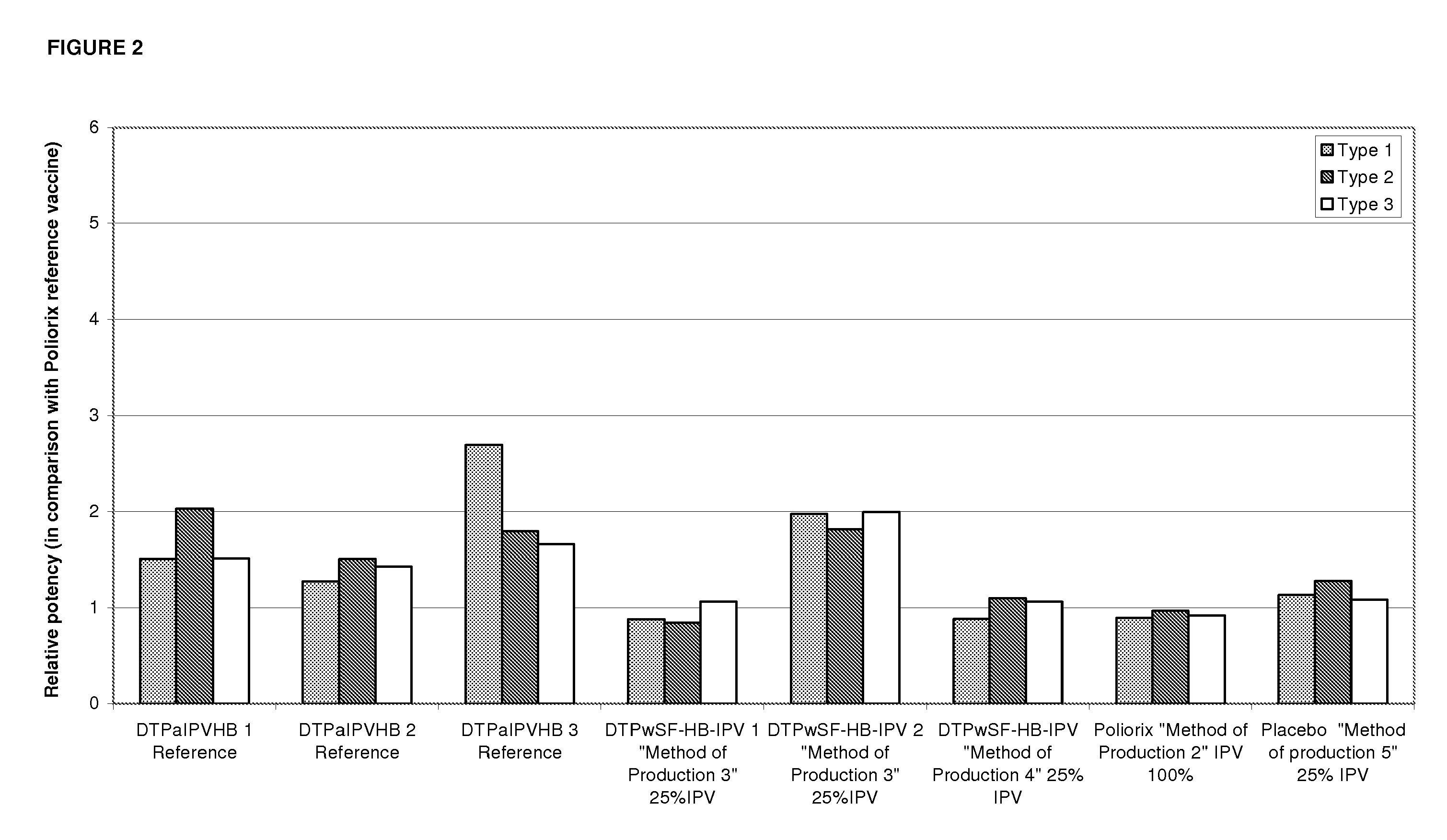Vaccine
a technology for polio and vaccines, applied in the field of vaccines for polio, can solve the problems of reducing the response to certain antigens, complicating the development of multi-component vaccines,
- Summary
- Abstract
- Description
- Claims
- Application Information
AI Technical Summary
Benefits of technology
Problems solved by technology
Method used
Image
Examples
example 1
Tests on low dose IPV formulations
[0184]For all the formulations of the example 1, the antigens are adsorbed by addition of aluminium salt prior to formulation except IPV which is added without adsorption.
[0185]The tables below present the adsorption method for D, T, Pw and HBsAg.
TABLE 1Method of productions for Diphtheria toxoid adsorption.FINAL COMPOSITION per doseDiphtheria7.5 Lf (+ / −420 Lf / ml)Al3+0.075 mgNaCl 150 mMpH6.1 + / − 0.1Volumeapproximately 18 μl
TABLE 2Method of productions for Tetanus toxoid adsorption.FINAL COMPOSITION per doseTetanus3.25 Lf (+ / −360 Lf / ml)Al3+0.070 mgNaCl 150 mMpH6.1 + / − 0.1Volumeapproximately 9 μl
TABLE 3Method of productions for Pw adsorptionFINAL COMPOSITION per doseAntigensAdjuvant[Al3+] (mg)Pw 20 OUAlPO40.170 mgAl3+0.170 mgAlPO4NaCl 150 mMpH 6.8 Volumeapproximately 65 μl
TABLE 4Method of productions for HBsAg adsorptionFINAL COMPOSITION per doseAntigensAdjuvant[Al3+] (mg)HBsAg 10 μgAlPO40.200 mgAl3+0.200 mgAlPO4NaCl 150 mMpH6.1 + / − 0.1Volum...
example 2
Feasibility of Using No Thiomersal in Vaccines of the Invention
[0228]The Preservative Efficacy Test (PET) allows the demonstration of the antimicrobial activity of the tested vaccine. The test consists in:[0229]challenging the vaccine preparation, in its final container step, with a prescribed inoculum of suitable micro-organisms,[0230]storing the inoculated preparation at a prescribed temperature[0231]withdrawing samples from the container at specified intervals of time and counting the organisms in the taken samples.
[0232]The PET testing procedure is described in the European Pharmacopoeia (5.1.3) and in the USP (). According to these guidelines, the antimicrobial activity is evaluated by comparing the reduction in the number of viable micro-organisms with the criteria mentioned in the following table (Table 7)
TABLE 7EP and USP CriteriaCriteria: log reductionMicroorganismsTimeEP AEP BEP CUSPBacteriaStaphylococus aureus6 h2Escherichia colid131Ni*Pseudomonas aeruginosad73Ni*1d1433d2...
example 3
Effect of Hib Component on the Potency of IPV and Stability of IPV Over Time
[0233]Relative potency of IPV was measured as described in Example 1 to determine the effects the Hib component may have on IPV potency and to evaluate the stability of IPV over time at different IPV doses. The vaccines investigated were DTPwHBIPV(40-8-32), DTPwHBIPV with reconstituted Hib and stored for 8 months, DTPwHBIPV(20-4-16), DTPwHBIPV(20-4-16) with reconstituted Hib and stored for 8 months, DTPwHBIPV(20-4-16) and stored for 8 months, DTPwHBIPV(10-2-8) and DTPwHBIPV(10-2-8) with reconstituted Hib and stored for 8 months. RP values were measure relative to DTPaIPVHB (Pediarix) (FIG. 3a) or Poliorix (FIG. 3b). It was found that the Hib component has no impact on IPV potency. The relative potency of IPV was found to be maintained at 8 months (FIG. 3).
PUM
| Property | Measurement | Unit |
|---|---|---|
| volume | aaaaa | aaaaa |
| concentration | aaaaa | aaaaa |
| concentration | aaaaa | aaaaa |
Abstract
Description
Claims
Application Information
 Login to View More
Login to View More - R&D
- Intellectual Property
- Life Sciences
- Materials
- Tech Scout
- Unparalleled Data Quality
- Higher Quality Content
- 60% Fewer Hallucinations
Browse by: Latest US Patents, China's latest patents, Technical Efficacy Thesaurus, Application Domain, Technology Topic, Popular Technical Reports.
© 2025 PatSnap. All rights reserved.Legal|Privacy policy|Modern Slavery Act Transparency Statement|Sitemap|About US| Contact US: help@patsnap.com



